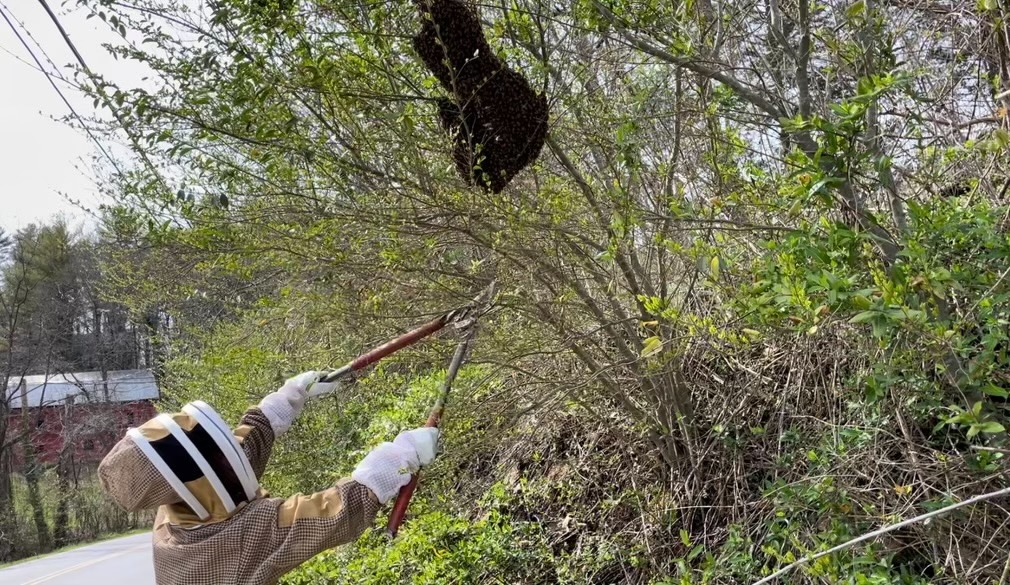Springtime Bee Swarms
go.ncsu.edu/readext?996027
en Español / em Português
El inglés es el idioma de control de esta página. En la medida en que haya algún conflicto entre la traducción al inglés y la traducción, el inglés prevalece.
Al hacer clic en el enlace de traducción se activa un servicio de traducción gratuito para convertir la página al español. Al igual que con cualquier traducción por Internet, la conversión no es sensible al contexto y puede que no traduzca el texto en su significado original. NC State Extension no garantiza la exactitud del texto traducido. Por favor, tenga en cuenta que algunas aplicaciones y/o servicios pueden no funcionar como se espera cuando se traducen.
Português
Inglês é o idioma de controle desta página. Na medida que haja algum conflito entre o texto original em Inglês e a tradução, o Inglês prevalece.
Ao clicar no link de tradução, um serviço gratuito de tradução será ativado para converter a página para o Português. Como em qualquer tradução pela internet, a conversão não é sensivel ao contexto e pode não ocorrer a tradução para o significado orginal. O serviço de Extensão da Carolina do Norte (NC State Extension) não garante a exatidão do texto traduzido. Por favor, observe que algumas funções ou serviços podem não funcionar como esperado após a tradução.
English
English is the controlling language of this page. To the extent there is any conflict between the English text and the translation, English controls.
Clicking on the translation link activates a free translation service to convert the page to Spanish. As with any Internet translation, the conversion is not context-sensitive and may not translate the text to its original meaning. NC State Extension does not guarantee the accuracy of the translated text. Please note that some applications and/or services may not function as expected when translated.
Collapse ▲There are many natural phenomena that signal the official return of spring. One of the most dramatic displays is that of a honeybee swarm. Swarms occur in the spring when honeybee colonies are building up their populations, and it’s a natural way for the bees to expand and maintain the overall health of the hive. With the variety of temperatures we experience in WNC in March and April, it’s not uncommon for swarms to occur after an abrupt shift to warm days. Honeybee swarms are certainly one of the most exciting harbingers of the changing spring season.
Beekeepers manage swarms in a number of ways, and when good management is coupled with a bit of luck, catching a swarm can result in an additional colony of bees added to the beeyard. Every spring, people will report bee swarms to local beekeepers, and the process of luring a swarm into a temporary container, and eventually into a new hive, is often a rite of passage for new beekeepers.
If you are lucky enough to observe a swarm in action here are a few tips to remember:
- First off, while swarms can look intimidating, they are actually quite docile. Swarms are not harmful, and will not attack people or pets. However you should not disturb them, as they are more vulnerable out of a hive, and are intent on protecting the queen as they locate a new home for the colony.
- If you see a swarm and you know there’s a beekeeper in your immediate area, alert them directly, as this gives them the opportunity to catch a swarm that may have separated from one of their original hives. Local beekeeping clubs are also a resource if you see a swarm: the Buncombe County Beekeepers maintain a resource through their website, https://wncbees.org/, where you can report a honeybee swarm. This is then shared with a list of beekeepers who will attempt to catch the swarm. Other local beekeeping associations also have similar resources, or lists of people to contact about swarms:
- Haywood County: https://hcbees.org/swarmremoval.html
- Henderson Co: https://hcbeekeepers.org/henderson-county-beekeepers/swarm-list/
- Remember that a swarm is a collection of thousands of living organisms, so time is of the essence if you are attempting to catch a swarm, or refer someone to where one is temporarily located. Don’t delay in reporting a swarm, as eventually they will relocate to an entirely new home of their own choosing, which could be a hollowed out tree or structure that meets their requirements. At that point it can be difficult for a beekeeper to retrieve them easily.
- In the event that a swarm relocates to a structure, this can lead to other problems, particularly if they are able to establish themselves over a long period of time. Removing honey bees from a structure is a difficult situation, as they are often in a hard-to-reach location in the structure, and the removal of siding and other building materials may be necessary, and costly. Buncombe County Extension can refer people in this situation to a local business that specializes in removing bees from structures.
When we talk about swarming insects, people often become alarmed that a more serious problem is at hand. In recent years there has been much discussion online about ‘killer bees,’ also known as Africanized Honeybees. Luckily this is not an insect that has been detected in North Carolina. Northern Giant Hornets are also not known to be in the state.
It’s important to be aware that all bees, wasps, and hornets play a critical role in our ecosystem, serving as an important food source for birds, and helping to mitigate other insect pests. The overwhelming majority of bees in our state are enormously beneficial, offering the ecosystem service of pollination for both cultivated and wild plant species. NC Extension has many resources to help you learn about and identify bees and other related insects:
https://content.ces.ncsu.edu/the-bees-of-north-carolina-identification-guide





